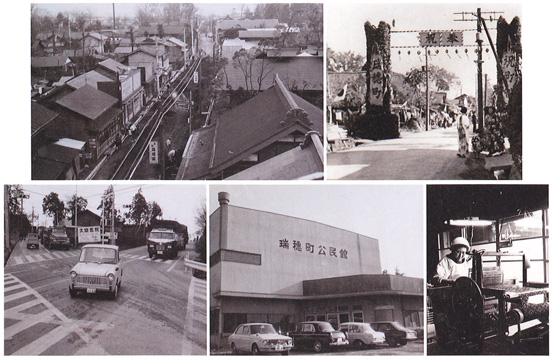| 徳川家康が江戸幕府を開府してから、江戸城築城や民家の土蔵造りのために大量の漆喰が必要になり、青梅で産出する石灰が建材として江戸へ運ばれました。このために整備されたのが江戸街道や青梅街道です。八王子千人同心の日光勤番が始まると、日光街道も整備され、街道沿線上の箱根ケ崎は、宿場町として発展しました。江戸中期には新田の開発も盛んに行われ新たな集落も誕生。経済の発展とともに、江戸へ出荷する蕎麦や茶の生産が盛んになっています。 | Large amounts of plaster were needed to build Edo Castle and warehouses for private residences after Tokugawa Ieyasu (1542-1616) established the Edo shogunate in 1603. Lime produced in Ome was taken to Edo for building materials, being shipped along Edo-Kaido and Ome-Kaido avenues, which were built for that purpose. Nikko-Kaido avenue was developed when the Hachioji constabulary began to serve as guardians in Nikko, and Hakonegasaki became a key post town along the route. New villages also appeared as new rice field development flourished during the middle of the Edo period. Shipments of soba to Edo and tea production flourished in tandem with the region's economic growth. |
| 維新により社会が激変した明治時代。町村制が敷かれると、この地域でも村々が連合し、箱根ケ崎村外三ケ村組合をつくり、役場を設けています。最終的に箱根ケ崎、石畑、殿ケ谷、長岡の各村が東京府に編入されたのは、明治26年のことでした。 | Society changed greatly in the Meiji era due to the restoration. Villages merged, and a municipal system was developed. Hakonegasaki and three other villages―Ishihata, Tonogaya, and Nagaoka―formed a union and built a village hall. The four villages were ultimately made a part of Tokyo in 1893. |
| 主要な産業だった養蚕は大正時代にピークを迎えます。近隣の地域で絹織物の村山大島紬の生産が盛んになり、養蚕業も栄えたのです。織物の生産は昭和に入って最盛期を迎えました。交通の発展も著しく大正14年には、乗合自動車が運行され、昭和5年に立川バスが運行。同6年には八王子~東飯能間に鉄道が開通し、9年には八高線が全通しました。そして昭和15年には、各村を廃して町制が施行されました。 | The major sericulture industry reached its zenith in the Taisho years (1912-26). The Murayama Oshima pongee silk goods industry flourished in a nearby district, and the sericulture industry prospered. Textile production reached its peak as the Showa era (1926-89) began. Transportation grew remarkably, and buses went into service in 1925, with the Tachikawa Bus line beginning to run in 1930. A rail line between Hachioji and Higashi Hanno started operations in 1931, and the entire Hachiko Line was up and running by 1934. Villages were all abolished in 1940 with the enactment of the town system, and the town of Mizuho was born, which was part of a long-standing plan. |
| 昭和20年に太平洋戦争が終わり、横田基地が開かれた後、瑞穂町は町としての機能を整えてきました。 | World War II ended in 1945, and Mizuho gained the more formal functions of a town following the establishment of Yokota Air Base. |
| 昭和28年、市町村合併促進法が成立すると、昭和33年東京都西多摩郡瑞穂町と埼玉県入間郡元狭山村は越境合併し、現在の瑞穂町域が成立しました。 | After the enactment of a 1953 law to promote the merger of municipalities, Mizuho (part of Tokyo's Nishitama District) took its current form following a cross-border merger with Motosayama in Saitama Prefecture's Iruma District in 1958. |
| 昭和40年代に入ると、日本全体が高度経済成長の時代となり、瑞穂町でも様々な施設が建設されるようになります。昭和43年には町民会館(旧公民館)、昭和47年には狭山谷公園プールと福祉会館、昭和48年には図書館と、続々と新しい建物が町にそろいました。また、この頃に新青梅街道が国道16号まで開通しました。その後も日本の好景気に合わせあらゆる施設が建設され、町民がゆとりある生活を送るための基盤が整ってきました。 | Japan as a whole entered a era of high economic growth starting from around 1965, and various facilities were built in Mizuho. The new buildings that followed one after another included the residents' hall (former community hall) in 1968, Sayamadani Park pool and welfare hall in 1972, and the town library in 1973. Shin-Ome Kaido road linked up with National Route 16 around the same time. Various other facilities were subsequently built in tandem with Japan's economic boom, providing the infrastructure for town residents to lead comfortable lives. |

